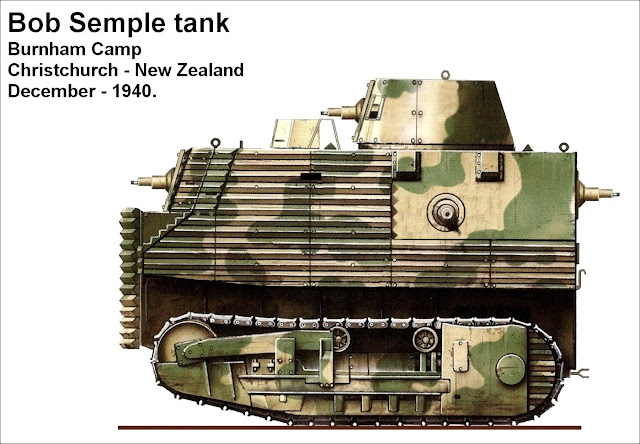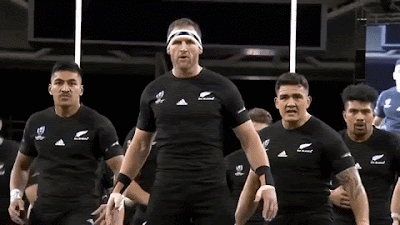New Zealand has a secret weapon...
Ladies and gentlemen, today we are going to visit a story that many may consider humorous or ridiculous, but it is the story of a war vehicle that was conceived in a very difficult time, with very few resources, in the face of great danger. Today we are going to see the story of a tank that many classify as "one of the worst tanks in the world", but many consider it as a testament to perseverance and courage: With you, the strange and massive Bob Semple tank, the secret weapon of New Zealand !!!
.jpg) |
| Bob Semple's tank panting on top of a hill at Burnham Camp, near Christchurch - New Zealand 8th October - 1941 - (Canterbury Museum) |
History:
The Bob Semple tank was a tractor-tank designed by Robert Semple, a controversial New Zealand Minister of Works, during World War II and Thomas George Gordon Beck, the engineer in charge of the Rangitata Diversion Race, the huge irrigation schemes in South and Mid-Canterbury, New Zealand.
 |
| The "fathers" of Bob Semple tank. |
Originating out of the need to build military hardware from available materials, the tank (sometimes referred to as Big Bob tank) was built with sheet mild steel, with additional angled corrugated metal armour, on a tractor chassis. Designed and built during a period of uncertainty in which New Zealand feared having to defend itself from Japanese invasion without external assistance, these tanks were a civilian effort to design and create a means to protect New Zealand.
Designed and built without formal plans or blueprints, it had numerous design flaws and practical difficulties, and was never put into mass production or used in combat.
Design and construction
New Zealand, like its neighbor Australia, had no indigenous armored fighting vehicle industry. It was expected that armored fighting vehicles would be provided from Britain. Australia and New Zealand did have some heavy industry that could be turned to the production of armor and armoured vehicles but little had been done. The idea of mechanising the New Zealand Army had been suggested before the war but without much progress.
The origins of what would be called Bob Semple tank are quite nebulous. In fact, it all started with an inquiry about armor by the Department of Defense to a New Zealand subsidiary of Henry Disston and Sons of Philadelphia in the USA in November 1939. The Army was desperately trying to obtain armor plates for a program to build Bren Carriers in New Zealand and Disston was seen as a potential source.
This company not only produced armor plates (although with low availability), but also produced some armored vehicles adapted to different models of Caterpillar tractors, some of which were ready for delivery. As an example of one of these vehicles, we can cite the example is the Disston Six Ton Tractor-Tank, a 1937 vehicle constructed of an armoured box on a Caterpillar Model 35 chassis.
Eager to make the sale, Disston sent in some technical specifications and photos of their tractor tanks. These photos and specifications eventually found its way into the hands of Bob Semple, who felt that something along these lines could be produced in New Zealand. He showed the photos and technical specifications to Thomas George Gordon Beck, the engineer responsible for the large irrigation schemes in South and Mid-Canterbury, who was then based in Temuka. Beck agreed to try to develop a similar project, despite having no military experience. But Beck was an inventive and creative engineer and was excited by the possibilities of building a national armored vehicle.
The construction of a prototype tank based on a D8 tractor was authorized by Public Works Department (PWD) in the early 1940s, with the intention that it would be in the national interest if such vehicles were manufactured locally rather than purchased abroad.
Not only for the cost factor, but also for the speed of developing the project. In fact, PWD felt they could do all the work for almost half the cost. They already had enough D8 tractors available (81 in total) and the technology to build the armored hulls for these tractors. They were confident that once the initial design was finalized, the hulls could be built to convert all of the PWD's D8s into defensive weapons.
 |
| Caterpillar brochure drawing |
The basic concept was that instead of committing all tractors as tanks, the armored hulls could be stored in strategic places until the country was threatened. Should this occur, the tractors would be quickly dispatched to these storage centers where their chassis would be fitted with their armored hulls and shipped to their designated defense areas.
 |
| Bob Semple tank concept: an armoured hull bolted on Caterpillar tractor chassis |
Under that premise, the proposal was indeed very attractive and the Army was interested enough to ask PWD to proceed with a wooden mockup of their proposal.
The building of this prototype began at PWD's Temuka Workshops in June, 1940. The driver seat, dashboard, hood, fenders and other accessories were removed from a standard D8 tractor and the controls were moved to a position on the left side of the vehicle, next to the engine. The controls for starting the engine were moved to a position that could be operated from inside the tank. Mild steel extensions were added to the tractor's chassis and then a wooden and plywood prototype body was built over this structure.
 |
| The very early layout of Bob Semple tank Notice the standard suspension and tracks from Caterpillar D8 tractor and the short and tall hull, with 360° rotation turret |
The completed mock-up was about 3.60 m high to the top of the turret, which would theoretically be armed with a light cannon, which could fire high-explosive projectiles. The initial proposal would be the installation of a QF-2 pdr. (40mm) Pom-pom AA gun or even an american M5 or M6 37 mm tank gun in the 360° swivel turret, as main armament.
 |
QF-2pdr. Pom-Pom AA gun in naval mount, route from Halifax to Britain, 10 July 1940. |
 |
| 37mm M5 tank gun |
Secondary armament would consist of Vickers, Lewis or Bren 0.303 inch machine guns: two in front of the tank and three in ball mounts on each side and rear of the tank.
The wooden mock-up was inspected by the Army personnel on June 16, 1940. The military did not like the vehicle's excessive height, but the possibility of using the cannon in a full swing calmed them down a bit. They commissioned the construction of an operational mild-steel prototype and with its completion in mid-July, the the military were called in for a static evaluation. Unfortunately, the PWD was unable to obtain a light cannon to equip the turret, installing a dummie machine gun there, instead.
 |
| Main guns to Bob Semple tank turret |
The absence of a more powerful weapon in the turret proved to be a true breaking point, with the Army recommending that the best, then, would be remove the turret to reduce the height and weight of the vehicle (...but PWD didn't want to go down that path...) . And they was also dissatisfied with the use of observation slots on the tank, considering them totally outdated, inappropriate and dangerous. The correct would be the installation of periscopes.
After this static inspection, the vehicle was transported to a field test in the Opihi River Valley (adjacent to Temuka), where things got tricky.The tank fell into a ditch and the tracks jumped off the suspensions, requiring another tractor to free the vehicle. We can hardly say that it was an auspicious debut.
Again, the Army expressed its dissatisfaction, requesting that something be done about improving its performance in difficult terrain, and also stated that the prototype should reach a speed of at least 24 km/h, before giving its approval for the continuation of the project.
Another critical point was the proposed protection given by the tank's armor. The military felt it should at least be proof against 12.7mm (0.5 inch) armor-piercing rounds and requested that live fire tests be carried out on the tank. PWD made some inquiries into the possibility of purchasing armor from Australia, but the demand for it at the time was such that no armor could be made available to New Zealand. But even if these armors were obtained, there was concern that the PWD did not fully master the welding technology of these armors.
In August, PWD sent six samples of different types of armor plates to the Army Ordnance Depot in Trentham for ballistics testing, against the fire from a 0.5-inch Vickers heavy machine gun.
 |
| Vickers .50 heavy machine gun right and left view |
These sample plates were:
- Plate with 14.3mm (9/16 inch) mild steel.
- Two layers of 12.7mm (1/2 inch) mild steel plates welded together.
- A set of 14.3mm (9/16 inch) outer plate, 6.35mm (1/4 inch) middle plate, 3.17mm (1/8 inch) inner plate, all mild steel, 6.35mm (1/4 inch) spaced, filled with concrete.
- A set of 14.3mm (9/16 inch) outer plate, 6.35mm (1/4 inch) back plate, with 6.35mm (1/4 inch) diagonal plates welded between them, all mild steel.
- Plate with 12.7mm (1/2 inch) flat manganese-steel bolted to 14.3mm (9/16 inch) mild steel.
- Plate with 12.7mm (1/2 inch) serrated/ribbed manganese-steel bolted to 14.3mm (9/16 inch) mild steel.
The 0.5-inch Vickers heavy machine gun pierced all plates from 1 to 4, while in the type 5 and 6 only a few shots penetrated. Plate 6 (serrated/ribbed manganese-steel) was selected, even though it was heavier than the flat plate, because it had the added advantage of deflecting some of the projectiles outward.
 |
| Schematic drawing with the different thicknesses of corrugated manganese-steel armor. |
The tank was returned to Temuka's workshops for the improvements. The engine structures were cut and extended by 60cm. A secondary 2:1 gearbox was built and installed in between the engine and the existing gearbox to reach the tank speed to 24.5 km/h. An upswept idler was fitted in front of the roller frames and the tracks extended to give extra traction in rough terrain, to the tank. These changes required a lengthening of the tank hull by 90 cms, and the engine compartment was reduced by around 30 cms. Also, the flat radiator front plate was replaced with one with a shallow V-section, in an attempt to improve ballistics. The extension of the tank's hull involved the insertion of three panels in the roof and one on each side, as shown in the drawing below. Unfortunately, this had the effect of pulling the commander's dome away from the machine gun he was supposed to operate. Also notice the suspension extension (front portion) and tracks.
 |
| Evolution of Bob Semple tank design: the short and the extended and final version |
After Temuka's upgrades, the tank was transported to the hills around Hororata in September, for yet another field test. Finally, an acceptable speed was achieved, but the tank's weight and high center of gravity did not improve the rough terrain performance at all, which was not much better than the previous test.
Returning to Temuka Workshop, the additional gearbox was removed (sacrificing speed...) and the engine frames returned to their original state. But the extended track frames were retained and the V-shaped front plate was installed flush with the front of the hull, greatly improving the vision of the gunners and the driver.
The dummy gun stations were removed and replaced with spherical mounts with a Bren .303 light machine gun, which was the weapon of choice (or available) for the tank.
The Brens were installed as follows: one in each side, two facing the front, one in the turret and one at the rear. Probably the Brens installed in the tank should have drum-type magazines, with 100 rounds, much more effective in maintaining fire than the curved magazines, such as those used by the infantry, which held a maximum of 30 rounds. These machine guns with 100-round ammunition barrels were the most used in vehicles and in the AA function.
 |
| Bren light machine gun (LMG) .303 with complete maintenance kit and spare barrel. Notice the 100-round detachable drum-type magazine more. |
 |
| Soldier of 8th Royal Scots equipped with .303 Bren gun (30 rounds curved magazine) advancing to Moostdijk, The Netherlands, 6 November 1944. |
The crew for the Bob Semple tank varied, with some sources citing 6 and others as many as 8. The crew included a Commander, who could or could not handle the turret machine gun, a driver on the front left side of the vehicle, three gunners in the hull machine guns on the sides and rear, in addition to a frontal gunner, on the right side of the tank and a gunner lying on a mattress on top of the compartment of the tank engine, handling the frontal central gun of the hull. If the Commander does not wield the turret weapon, one more gunner would be assigned to the task, totaling 8 crew. An economy of men would be for the Commander to wield the turret gun and the two side gunners taking turns with the rear machine gun.
 |
| The schematic drawing above shows the combat stations - full option. In blue, the Commander and the driver and in green, the gunners. |
Continuing with the vehicle's development, armor plates were installed on the tank. In the turret, four curved plates, riveted, with 12.7mm of manganese steel, were installed on the sides and rear while a flat plate was mounted on the front, spaced apart to free up the gun ball mount and sight slits. The corrugated armor was installed on the front and sides of the hull while flat armour plates were riveted protecting the two ball mount forward machine guns and the tank driver hatch.
 |
| The Bob Semple tank being fitted with its corrugated armour. By this stage, the 2:1 gearbox had been removed and the radiator plate moved back until it was flush with the hull front. The slits either side of the turret machine gun have now been replaced by shutters. The machine gun ball mounts for Bren guns have now been installed, the gun being sighted through a triangular hole in the mount beside the barrel. Temuka Workshops, New Zealand. November - 1940. |
Concerned about the weight factor, Army personnel recommended that the top, rear and sides of the upper rear be left without the corrugated armor. Triangular-shaped rails running the entire width of the hull roof protected the turret ring (front and rear portion) from small arms fire, while a guardrail on one side protected the rear of the commander's cupola from machine gun fire. of the turret, restricting its depression in that region. The installation of armor plates considerably increased the already excessive weight of the vehicle. Another round of field tests was carried out at Burnham Camp, near Christchurch, in December 1940. This time the vehicle was evaluated by Colonel L.G. Goss.
 |
| Temuka built tank at Burnham Camp - left side view Note the distribution of corrugated armor, following the Army's recommendations to save weight. 7 December 1940. |
 |
| Temuka built tank at Burnham Camp - right side view 7 December 1940. |
 |
| Temuka built tank at Burnham Camp - front view. Notice that the corrugated armor covers all front of the tank and steel armour plates riveted in the front MG hull positions, turret and driver hatch. |
With the removal of the 2:1 gearbox, the tank returned to poor 8-10 km/h performance in cross-country conditions and continued to exhibit longitudinal and transverse instability when on uneven terrain, making fire accuracy extremely difficult. when in motion. Seeing the Semple Tank move, Colonel Goss concluded that the tank's great mass, along with the absence of a suitable cannon, simply restricted the vehicle's operational employment to a mobile pillbox or as an armored personnel/ammunition carrier. And again, the Army issued an ultimatum for the installation of a cannon in the turret or its complete removal. And, strangely, despite the heavy criticism that came from observing the field tests, in their final recommendation the military reported that six vehicles would be needed (two for each military district), although this claim was soon reduced to a total of just three tanks.
By January 1941, PWD contacted New Zealand Railway Workshops (NZR) in Addington, Christchurch, asking if they could build two additional tanks and a special wheeled trailer to transport them. With the acceptance, the tank and existing designs were shipped to Addington at the end of the month. Work on the hulls and gun emplacements began immediately and by the time the first tractor was received, around mid-February, the armored hulls were ready to be assembled. The second tractor was delivered in late February and by late March both tanks were complete enough to be included in an NZR-made military equipment display in Addington.
The tank transport trailer was completed in early April. This had a platform-type design, with a 3-axle suspension. It was large, 2.60m wide and 7.90m long. The tires and wheels came from a city bus. The trailer when built weighed 30 tons and its load capacity was 20 tons per axle. The problem is that this weight far exceeded the standard weight requirements for bridges in New Zealand, making this transport system unsafe, but it seems PWD ignored this "little detail"!
 |
| This is the Temuka Bob Semple tank, in his trailer. Notice the corrugated armour not involving the right ball gun mount, compared to the photo above. 21 April, 1941 - (Christchurch Star-Sun) |
In mid-April, the tank was inspected once more, this time by Colonel Milner. And the report of that inspection really was not at all favorable to the vehicle: in the Colonel's opinion, the tank was practically a throwback in terms of performance and design to the pioneering times of the WWI; weak armor, insufficient and too slow and bulky to be operationally useful in any of the functions provided for the vehicle. Milner categorically stated that two or three Bren Gun Carriers could be built for the price of the tank being tested and these Carriers would be infinitely more useful to the country. Naturally PWD was extremely disappointed by this verdict, although that didn't stop them from showing the vehicle at three more shows, one in Wellington on 19 April, another in Christchurch on 26 April and the other in Auckland on 10 May.
 |
| Bob Semple tank crossing the Bridge of Remembrance during parade through Christchurch - New Zealand Notice that right headlight in the front armour is open and Manuka wooden pads in the tracks, to protect the streets. 26 Apr. 1941 |
 |
| The same Bob Semple tank above, with full corrugated armour roaring in parade by Cashel Street, Christchurch. Notice the wooden pads in the tracks. New Zealand - 26 April 1941. |
 |
| Bob Semple Tank taking part in a parade in Queen Street. Notice the partial side corrugated armour Auckland, New Zealand - 10, May - I94I. |
 |
| The same Bob Semple tank, from the photo above parade in the city of Auckland - New Zealand Notice that headlights in the front armour are closed. 10 May, 1941. |
The exposure of the vehicles in the parades had almost the opposite effect to what was desired, as their erratic behavior and precarious locomotion triggered a series of mocking comments in the population about the supposed validity of the weapon. This bad appearance to the public, along with Colonel Milner's reports, created embarrassment for both the PWD and the Army. More and more questions were asked about the real contribution to the war effort that these vehicles could make, in relation to their economic cost and industrial effort. The general opinion was that the work on the Semple tanks should be stopped, as the alleged improvements were always nullified by a bad concept of conception, which was incorrigible.
 |
| Gordon Minhinnick cartoon about the Bob Semple tank. Notice the caricature of Bob Semple, in the driver's position. The artist has captured the appearance of the tank and its creator very well. The tank also features the wooden pads on the track links and the partial corrugated armour of the side, just after this model have been featured in the Parade on the 10th May (see pics above) New Zealand Herald - 13th May 1941. |
 |
Another Gordon Minhinnick cartoon featuring the Bob Semple tank It was published shortly after the arrival of the first Valentine tanks in New Zealand. The Big Bob tank has some "creative liberties", such as the hatch in the top turret (where Bob Semple's impassive head emerges...) and the engine exhaust, emitting a jocular tuff...tuff...tuff... But the icing on the cake is the centrifugal steam governor on the rear deck!! Really, Minhinnick was really very good!!! New Zealand Herald - 21st October 1941 |
In a final effort to try to salvage the project, another inspection was scheduled. Bob Semple, Gondon Beck and Lieutenant General Edward Puttick, who had just arrived in New Zealand from the North African Campaign, to assume the position of Chief of the General Staff. They visited Burnham's camp in 8th October, to inspect the tanks.
 |
| Bob Semple and General Edward Puttick standing by one of the tanks at Burnham Camp. Notice the full corrugated armor on the side of the tank. Indeed, the girl was very huge!!! 8th October -1941 |
.jpg) |
| Bob Semple's tank panting in tests, on top of a hill at Burnham Camp, near Christchurch - New Zealand 8th October - 1941 - (Canterbury Museum) |
As most things remained the same, General Puttick suggested carrying out a real test of fire. This tests were scheduled for the end of the month at Ellesmere Air Force Base, near Christchurch. On this occasion, about 1,000 projectiles were fired from the tank as the vehicle moved across the test field, with no dangerous effect on the crew. But when the tank was targeted by live fire, the situation changed: shrapnel from the projectiles of .303-inch Vickers light machine gun used in the test were found inside the tank, which penetrated through the vision slits in the commander's cupola and through the ball mounts of the machine guns. Finally, it was decided that the tanks would have their turrets removed.
In January 1942, the two vehicles in Christchurch were sent back to Addington to have their turrets removed and the opening covered with a 12.7mm mild steel plate. The people involved in the project were so discouraged that this work was not completed until April.
With controversy arising from criticism, the idea of producing Bob Semple hulls was discarded, but even under the mockery, Robert Semple kept his design and even said, sensibly: "I don't see anyone else with better ideas". Another example of the veracity of the statement that reads: "Desperate times generate desperate solutions".
We cannot forget that England itself, after the Dunkirk disaster, where it lost a large part of its armored material, had to resort to at least unusual solutions for its domestic defense, in fear of an amphibious invasion by Germany. . We have already discussed this in the articles about the Beaverettes.
 |
Beaverettes Mk II with .303 Bren LMG of 53rd Reconnaissance Regiment on manoeuvres Northern Ireland, 1941. |
There are no records of service by the Army of the three Bob Semple tanks. There is a report that one of the vehicles at Burnham Camp was used to remove some Macrocarp trees around the Mess of Sergeants and Officers of that Camp. The tank in question had no trouble pushing the trees, uprooting them and dragging their trunks and branches. By the end of 1942 the Southern Military District (SMD) had received M3 Stuarts light tanks in sufficient numbers that they could consider the Semple tanks superfluous. The SMD commander contacted PWD in Christchurch and asked if they would welcome the two Semples tanks back. PWD readily agreed and asked about the vehicle in Auckland. In this case, the Army replied that it wished to keep this vehicle, but like tractor and that it only required that it be stripped of its armor and then returned to them. The two vehicles at Burnham were promptly handed over to PWD, reverted to civil service as tractors. The tank in Auckland was not delivered until May 1943 and it was not until August that the demilitarization work was completed. Armor plates, weapon ball mounts, and other salvaged materials were returned to PWD's Temuka Depot and apparently consigned for scrap. The final fate of the armor plates is unknown, although some corrugated plates were used as targets in the Waiouru Ranges in the 1950s. A piece of corrugate plate from one of the side visors survives and is now preserved at the South Canterbury Museum in Timaru.
And this is the last remnant that has survived to this day, of the troubled history of the three Bob Semple tractor tanks.
 |
| Last survive part of Bob Semple tank: corrugated plate from one of the side visors. finder: Mr. Bob Dunnill South Canterbury Museum - Timaru - New Zealand |
Identifying the three Bob Semple tanks:
A major problem is the difficulty of "positive" identification of the three tanks built, given that the photographic records omit this information. But we can, by the photos, dates and places where they were taken, try to individualize and identify the three Bob Semple Tanks.
Let's get to the facts:
- The first tank was built in Temuka, with photos and date references. We can call this tank Bob Semple Temuka Tank no. 1 as it was the first to be built. This is the tank that was built short in July, 1940 and elongated in September, 1940 (see the drawing above, in this report). This tank, after improvements, was sent for testing at Burnham Camp in December 1940. And this same tank was photographed in April 1941, on its trailer, with no modifications, in a series of parades scheduled for April and May. How do we know it's the same tank?? Due to the extension of the corrugated armor at the rear, leaving the .303 Bren ball mount unprotected and the detail of the reinforcement of the suspension, in a rectangular shape. See the photos below, with the mentioned details highlighted.
 |
| Notice, in red, the same extension of the corrugated armor and in blue, the reinforcement of the suspension, in a rectangular shape. Let's call this tank Temuka no.1 |
- Now, let's try to identify the second and third Bob Semple tanks, which as we know were built at New Zealand Railway Workshops (NZR) in Addington, Christchurch, in late March 1941. Don't forget they were built in a hurry, to participate in the aforementioned parades. Therefore, these parades had the 3 vehicles built, and for these events, we have photos of the 3 and we know that they did not suffer any "intervention" when in transit to these events. The first tank, the Temuka no.1, on it's trailer, being transported to the first first parade.(see pic above, right image).
- Let's see the NZR girls (photo below): Notice that the "left girl" (NZR no.2 -10 May, 1941) feature corrugated armor different from Temuka no.1 (red aquare, above), that is, armor surrounding the Bren ball mount, but not completely (yellow aquare, below), and the "right girl" (NZR no.3 - 26 April, 1941) show armor FULLY covering the side of the tank (purple square, below). And as these three individuals were photographed going to or at the Parades, at the same time (and without undergoing upgrades, as they were in transit), we can deduce that they are three different tanks: The Temuka (no.1) with ball mont without corrugated armor (red square), the NZR no.2 (let's call it that) with the ball mount covered, but still with the rear portion exposed (yellow square) and the NZR no.3 fully covered by corrugated armor (purple square).
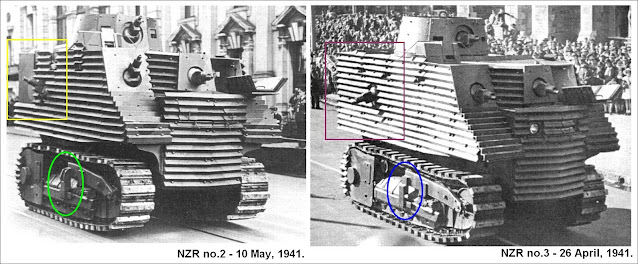 |
| New Zealand Railway girls: Tanks no. 2 and 3. Notice the vertical reinforcement of the idler wheel extension, on the front part of the suspension |
- Another differentiating detail is the vertical reinforcement of the idler wheel extension, on the front part of the suspension: on the Temuka Tank no.1 and on the NZR no.3, this reinforcement is rectangular (blue circle), while on the NZR tank no.2 it is in the shape of a fork (green circle). See these circular details in the two sets of photos above.
- And, finally, let's try to solve the mystery of the "Fourth tank" found in the photos... It would be this one, with the side all plated with the characteristic armor of the NZR 3, but with the "fork" reinforcment in the suspension, like the NZR 2.
 |
| Was there a fourth tank with features from the NZR 3 and NZR 2?? |
- And this "different" tank appears twice in the historical photos: climbing a hill at Burnham Camp (below, left) and being inspected by Bob Semple and General Puttick (below right)...And these events took place on the same day: October 8, 1941... Almost at the end of the Bob Semple tank project.
 |
| The same tank in two pictures: full side armour (purple) and fork like reinforcment of suspension (green) The light blue rectangle will be explained now... |
No, there was no fourth tank, but in another attempt to save the project, "full" armor was added to the NZR 2 tank, the only one with "fork" suspension. Let's face it, this suspension detail would be the last place they would modify, as it's just a reinforcement. The armor plates could be applied with some ease (their removal would be more complicated, due to the presence of the screw holes.) As the last photo we have with reference to NZR 2 dates is from the Auckland parade, on May 10th. 1941 and the photo of the "mysterious" tank (with the unique suspension characteristic of the NZR 2 ) is October 8, 1941, we can deduce that the PWD people had four months to upgrade the NZR 2 corrugated armor, so that it look the same "more armored" as the NZR 3.
The three Bob Semple Tanks, individually identified:
- Bob Semple tank - Temuka no.1
- side Bren gun ball mount without corrugated armor
- reinforcement of the suspension: rectangular shape
 |
| Bob Semple tank - Temuka no.1 |
 |
| Bob Semple tank - Temuka no.1 |
 |
| Bob Semple tank - Temuka no.1 |
- Bob Semple tank - NZR no.2 - early version
- Bren ball mount covered with corrugated armour, but the rear portion exposed
- reinforcement of the suspension: fork shape
 |
| Bob Semple tank - NZR no.2 - early version |
- Bob Semple tank - NZR no.2 - late version
- full side covered with corrugated armour.
- reinforcement of the suspension: fork shape
.jpg) |
| Bob Semple tank - NZR no.2 - late version |
 |
| Bob Semple tank - NZR no.2 - late version |
 |
| Bob Semple tank - NZR no.2 - late version |
- Bob Semple tank - NZR no.3
- full side covered with corrugated armour.
- reinforcement of the suspension: rectangular shape
Conclusion:
Due to requirements and resource limitations, the tank was a functional failure. Using a large tractor as a base and bolting on top of a poorly constructed and hastily designed armored superstructure, the resulting tanks were inadequately armored, extremely heavy (20 - 25 tons), unstable (because their center of gravity is too high) and had a poor maneuverability in the field, derived from a civil tractor mechanics focused on traction capacity and low speed. Furthermore, due to erratic driving and undue vibrations, firing the tank's weapons while moving was difficult, imprecise, and therefore tactically useless. These limitations have caused the Bob Semple tank to often rank first on the "Worst Tanks of All Time" list.
Below, is an interesting (unfortunately, recolored...) video that shows in the first minute of the movie, the Bob Semple tank - Temuka no. 1, roaring in tests, at Burnham Camp and then, a scene with Bob Semple tank NZR no. 2 - early version, in parade in the city of Auckland - New Zealand, on May 10, 1941.the movie is narrated in the elegant voice of New Zealander Russell "Gladiator" Crowe:
In the end, due to their impracticality, the tanks were discarded by the Army. In the event of a Japanese invasion, it is possible that the Bob Semple tank could have been potentially useful on the battlefield, as a mobile pillbox, supporting infantry with its machine guns. If it could have been built with a bigger weapon like a 2-pdr gun or even the 37mm gun, it might really make a difference, but it's something we (thankfully) will never know.
The important thing is that people tried to do something with what they had in hand, in the face of greater danger. And that should never be forgotten...
I would like to thank our fellow military modeler Rob Mooar who helped me enormously on this project. Many, many thanks, Rob!!
You are the man!!!
Specs:
| Bob Semple tank (Big Bob tank) | |
|---|---|
| Type | Tractor-tank |
| Place of origin | New Zealand |
| Production history | |
| Manufacturer Produced | Ministry of Works - Temuka only 3 :1940 - 1942 |
| Specifications | |
| Mass | 25.4 t |
| Length | 4.20 m |
| Width | 3.30 m |
| Height | 3.65 m |
| Crew | 6-8 on |
| Armor | 8mm - 12.7 mm |
Main armament | 6× 0.303 in (7.7mm) Bren light mg |
| Engine | 6-cylinder diesel 95 kW (127 hp) |
| Power/weight | 5 hp/t |
Operational range | 160 km |
| Maximum speed | 24 km/h |
Kit:
For this project, the option is the Vargas Models 3D printed kit (#R3D-35-061)
 |
| Vargas Models Bob Semple tank (#R3D-35-061) box art This is the last version of box art |
When I purchased this kit (2021) the box kit art was different (was in black and white). See the photo below...
 |
| Kojak with Bob Semple (old) box kit and all parts |
A criticism (and a suggestion) to Modelos Vargas is to be more careful with the presentation of the model kit that is being sold. In the box art, is mentioned that the tank is the number 1 (red square) and the drawing show a Bob Semple tank with corrugated manganese-steel armor involving the ball mount of the .303 Bren machine gun, but with a little space without the corrugate armour (which we call in the article as NZR 2...) (yellow square):
 |
| Vargas Scale Models box art... Things are a little confusing here... |
But the 3D printed scale model in the box is the Temuka 1 model (with Bren's ball mount fully exposed, unshielded). you buy a Sherman kit in which the box art shows an M4 and, when you open the box, the kit has an M4A1 hull. A little more care with these little big details, Luis Vargas!!! Your kits deserve it!!! I made a reconstruction of what I consider to be a box with the correct box art, which correctly indicates what the content is. Feel free to use this art, Luis!!!
 |
| Suggestion of a box-art compatible with the content. The question is not the name, which can be used Temuka or not... The problem is that the profile was different from the content. |
Another strange detail is that the date of the construction of the vehicle: is mentioned in the art box and in the instruction booklet as being 1941 and in the identification plate is 1940...
 |
| Which would be correct: the year of the box and instructions or the year of the license plate??? |
We know that the No.1 tank, built at Temuka, made its operational appearance (as depicted in the kit) at the Burnham Proving Grounds in December 1940. But why then put the year 1941 on the box art and instructions??? Which would be correct?? Both dates may be correct, as in 1941 tank no. 1 had the same external appearance as 1940, but why not specify or describe this possibility??
This dubiousness raises doubts in less experienced modelers... In my opinion, it could be easily corrected by changing the date of the box art and in the construction instructions, like the suggestion art above.
But one thing is definite: this is, without a doubt, the best 3D printed kit by Vargas Models that I've built so far. Infinitely better than the FT-17 ammo carrier, FT-17 75mm SPG and the Char Frot-Turnel-Laffly armored steamroller prototype.
The printed details are very good, the highlight being the delicacy of the corrugated armour shields... simply amazing!!! Very, very good!!!
 |
| Notice the corrugated armour plates.... Awesome!!! |
Congratulations, Vargas!!!
 |
| The people of Middle Earth are very happy!!! |
But going back to building the model, one of the things I like to do right away is test the turret on the hull, so I can get an idea of how the vehicle will look in the future. And, when doing this with the Vargas kit, I noticed that there is a certain gap between the turret and the neck of the hull. You see, I can't categorize this as a flaw, but I particularly like to make this a tight fit. I'm not "playing" with the kit, but this part being tighter, I think I can better visualize the model. Therefore, I decided to make an "adjustment" between the turret ring and the hull ring, adding a thin strip of plasticard glued (with super glue) to the inner portion of the turret ring (red arrows below).
 |
| The new inner diameter of the turret ring, after gluing the thin styrene. |
 |
| Turret rotating on the upper-hull's neck, smooth and perfectly fitted! Eyes left!! |
 |
| Turret rotating on the upper-hull's neck, smooth and perfectly fitted! Eyes right!! The King is pleased!! |
And speaking about Lord of the Rings (and New Zealand...), the marking solution of the kit found by Vargas was very cool: an internal relief, only noticeable by the translucency of the bottom of the tank's hull. On the outside, nothing... But seen against the light, inside... here's the image... Sooo THE ONE RING!!! Good thing it doesn't have to be thrown into the fire for the letters to be visible...
 |
| Very, very cool!!! |
The problem with building a kit from New Zealand is that I don't forget about Middle Earth!! But back to Bob Semple: I also sanded the prominent "neck" of the turret, leaving the base of the turret flat and smooth, as per the photos of the real vehicle. Simple and easy!!
 |
| I took out the neck of the Big Bob tank's turret... Goodbye, Giraffe!!! |
 |
| Really, the tank has some incredible details... |
 |
| Gluing the armor plate of the central machine gun... |
 |
| ... and pasting the armor plate of the right front hull machine gun. |
The mini-turret came with a small warp derived from the packaging, on the back wall... As the wall is very thin, I was worried about getting warm to get back into place. I will choose to glue a thin plasticard plate to rectify this small defect...
 |
| Let's fix that little ripple... |
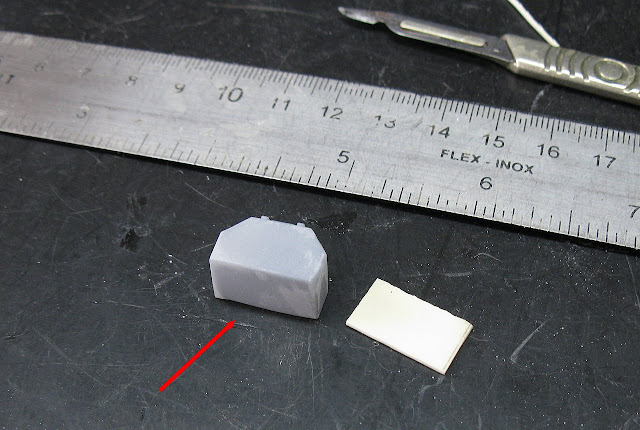 |
| Best option: glue a thin plasticard (0.2mm) to the back face of the mini-turret. And with that, the turret looks a little more robust... |
With the back plate in place, a small injection flaw was evident in the posterior right angle of the mini-turret, which was immediately filled with a styrene fragment and super glue.
 |
| Mini-turret with new rear armour plate and with the right rear angle rectification. Indeed, Samwise... the building of the tank is calm and easy... |
 |
| Mini-turret in position. Notice the driver's armour plate in position, too... |
 |
| Left view |
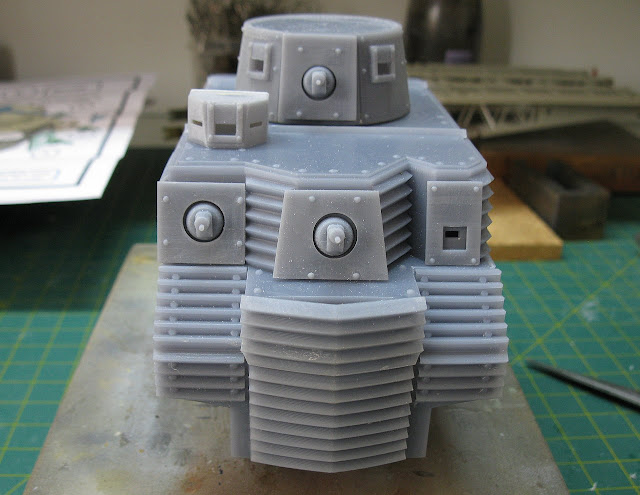 |
| Front view... Big Bob tank |
Now, let's take care of suspensions. The sets are well primed, although my kit came with a set of return rollers with a print defect.
 |
| Suspension sets very good ... Notice the flaw in a return roller |
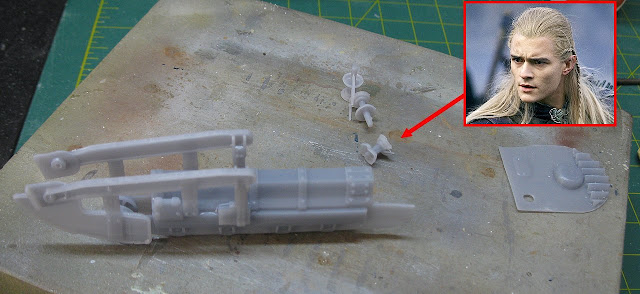 |
| Don't worry, Legolas!!! This return roller will be almost hidden... |
 |
| In place... Legolas is pleased with the result. |
Now, installing the suspension sets: the big pin is inserted into the hole in the hull (red arrows) and the suspension step rests on the hull step (green). Use superglue mini-drops and test the alignment of the set, before a more "vigorous" gluing....
 |
| Testing the fit of the suspensions sets... |
 |
| Pin in the hole (red) and step in the step (green)... |
 |
| Testing the vertical alignment... |
 |
| ...and the horizontal alignment. The popsicle sticks function as distance jigs between the suspension sets and the lower hull. |
 |
| Suspensions in position... Right view |
 |
| Suspensions in position... Left view. The Bob Semple tank is perfectly aligned on its paws!!! |
 |
| Detail of the closed (red) and open (blue) lifting hooks on the hull and turret. |
 |
| Front hull open (yellow) lifting hooks... The closed one is just front to the turret, in the top of front hull. |
I think I've already told you that I HATE leaving turrets without fixing on the hulls, because I've had an accident once with one of them falling, when handling a kit. I like to keep them moving, but I always try to make a locking system to avoid accidents. And with this girl, the story is the same: I'm going to make a locking system, with the turret that can be released with a 90° turn.
An important detail, which is visible in the photos of the real vehicles and is not part of the kit (one more suggestion, Vargas!!) is the bullet deflector arc of the turret's machine gun, to prevent the turret's Bren projectiles from hitting the " back of the mini-turret. This flat-arched bar "lifts" the Bren barrel, preventing "friendly fire"!
 |
| I made this bow out of leftover PE from my spare parts box. A detail that Galadriel simply loved...and approved!!! |
 |
| The deflector arc installed.... |
 |
| Rear right side view |
 |
| With the turret rotation to the right, the bow raises Bren, releasing the nape of the mini-turret from the fire bow. |
 |
| The same happens with rotation from right to left, from posterior to anterior. |
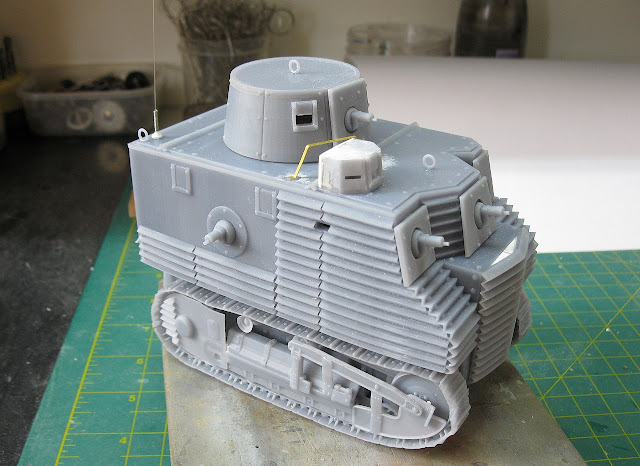 |
| I decided to install an antenna/mast on our tank... I think it deserves it!!! Rear right corner |
 |
| Rear view...These acupuncture needles are just perfect for that... |
 |
| And...our little tank is "mechanically" ready!!! |
 |
| Really, my precious!!! |
Now, it's time for the make-up of this girl.... Painting!!!
 |
| First of all, primer!! |
The colors would be that of tank number 2, with a grayish Khaki-like base color, with wavy camouflage with sharp greenish edges, just like the profile below:
I decided to make the base color with a mixture of three different colors but with similar shades... Here's the cake recipe:
 |
| Colors and shades of the color-base... As you can see, I am extremely ecumenical with paint manufacturers |
 |
| Color base - right view |
 |
| Eeeeyeesss Right!!! |
 |
| Eeeeyeesss Left!!! |
 |
| Paint mask made with masking tape and Play-Doh Right side |
 |
| Paint mask made with masking tape and Play-Doh Left side and turret |
 |
| Shades of green... |
 |
| Indeed, this Vargas Models kits is awesome!!! Temuka Big Bob tank no.1 - left view |
 |
| Temuka Big Bob tank no.1 - front view |
 |
| Temuka Big Bob tank no.1 - right view |
 |
| Temuka Big Bob tank no.1 - rear view... Next, weathering!!! |
My intention is to show you our girl performing a little dirty as she just passed by field tests in Burnham Camp, near Christchurch, in December 1940. With you, Bob Semple tank (Temuka no1)
 |
| Bob Semple tank no.1 (Temuka). Burnham Camp, near Christchurch. New Zealand - December 1940. |
 |
| Bob Semple tank no.1 (Temuka). |
 |
| Bob Semple tank no.1 (Temuka). left side |
 |
| Bob Semple tank no.1 (Temuka). left side - top view |
 |
| Bob Semple tank no.1 (Temuka). left rear side view |
 |
| Bob Semple tank no.1 (Temuka). right rear side view |
 |
| Bob Semple tank no.1 (Temuka). right side |
 |
| Bob Semple tank no.1 (Temuka). right side - top view |
 |
| Bob Semple tank no.1 (Temuka). She's staring at you.... |
 |
| Bob Semple tank no.1 (Temuka) front left side view |
 |
| Bob Semple tank no.1 (Temuka) with Kojak. Indeed, the girl is huge!!! |
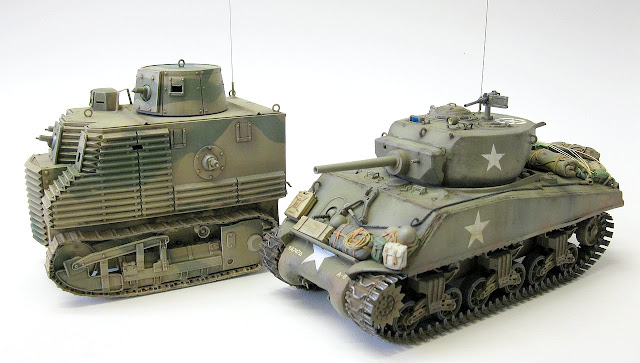 |
| From the series "Impossible Encounters", Bob Semple tank no. 1 (Temuka) alongside an M4A3E2 (75) Jumbo Assault tank |
 |
| Bob Semple tank no.1 (Temuka). Burnham Camp, near Christchurch. New Zealand - December 1940. |
I just LOVED this project, because with the historical research, I got to know something much more interesting and profound than a vehicle that many consider "the worst tank" ever built.
But to paraphrase Bob Semple: "I don't see anyone else with better ideas"...
Talking today is easy... but acting in those old times of fear and anguish of 1940, in front of the unstoppable Japanese Tsunami, the thing was a little different ...
Go, Kiwis ...Go!!!
























